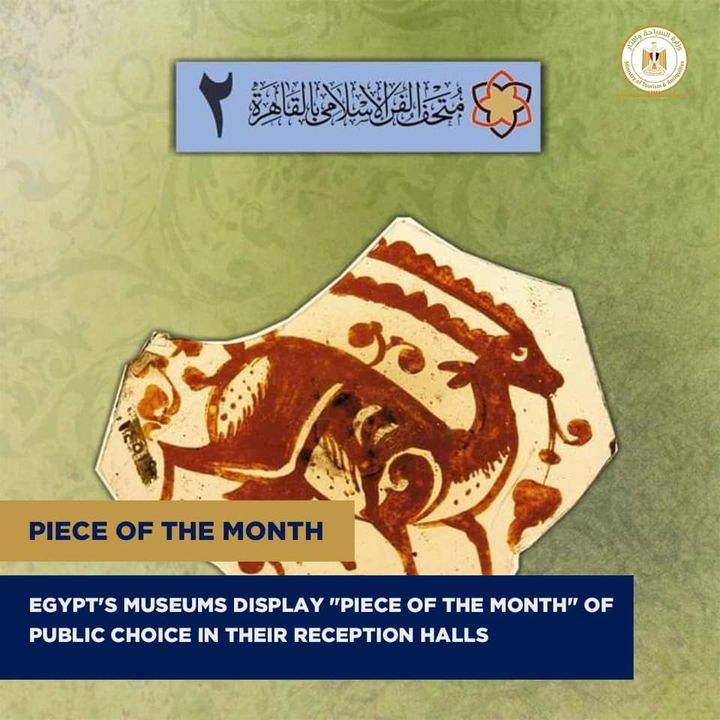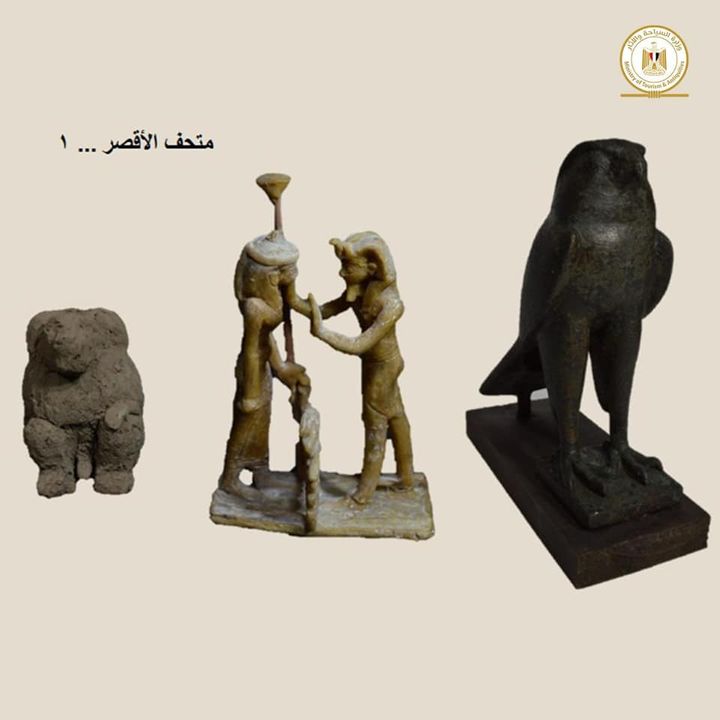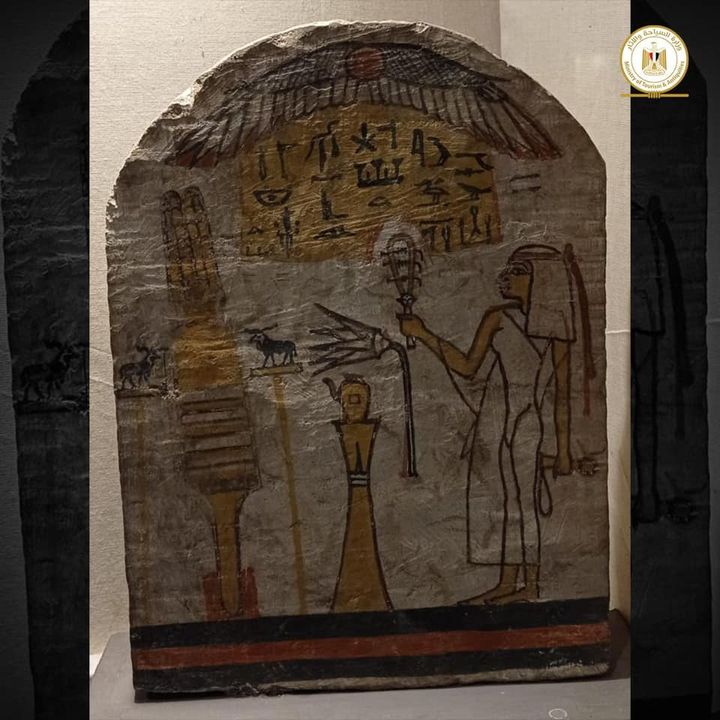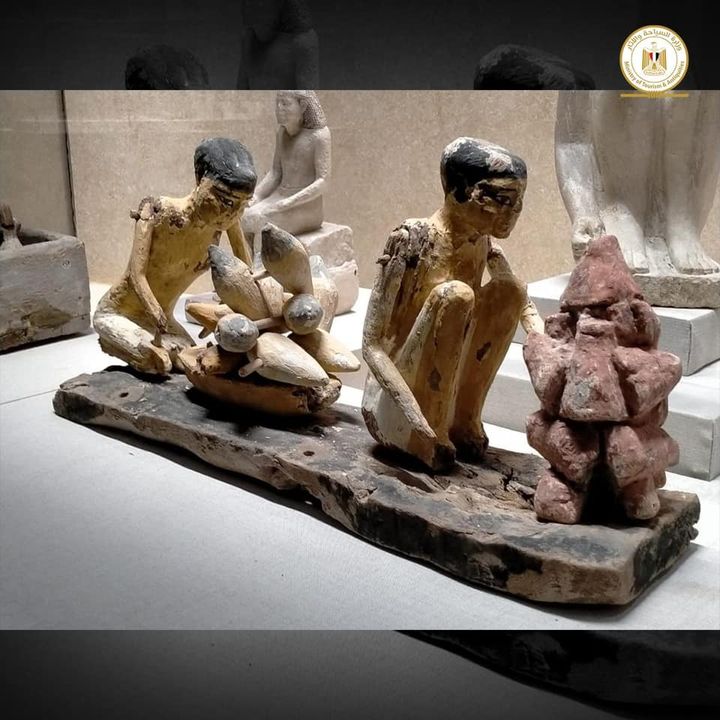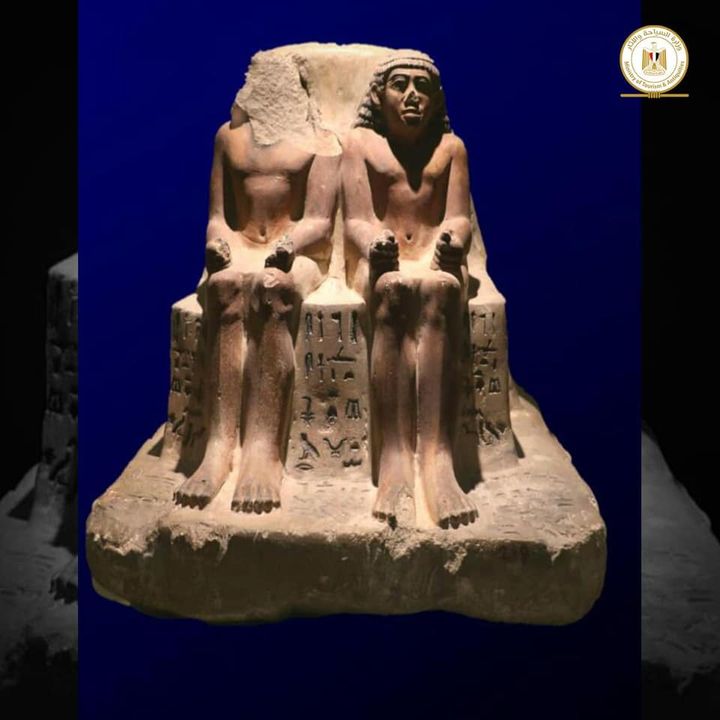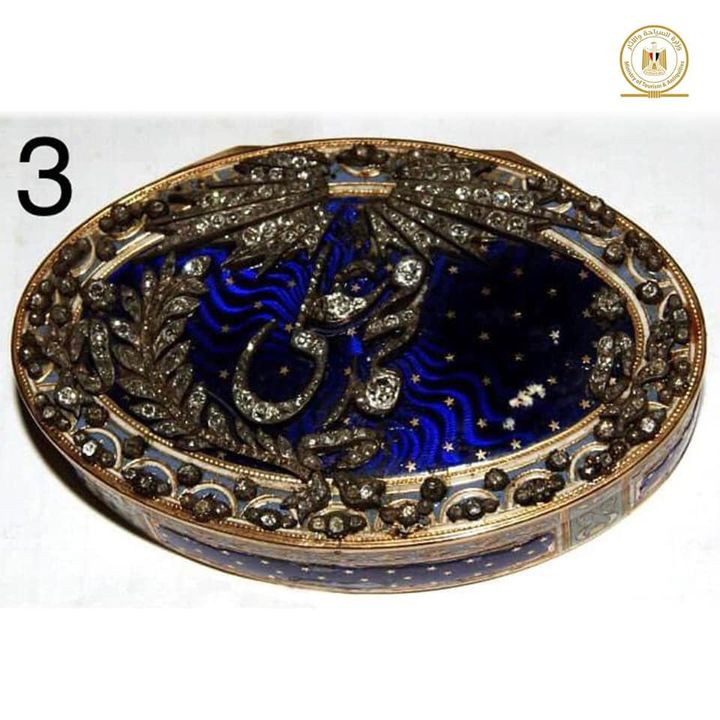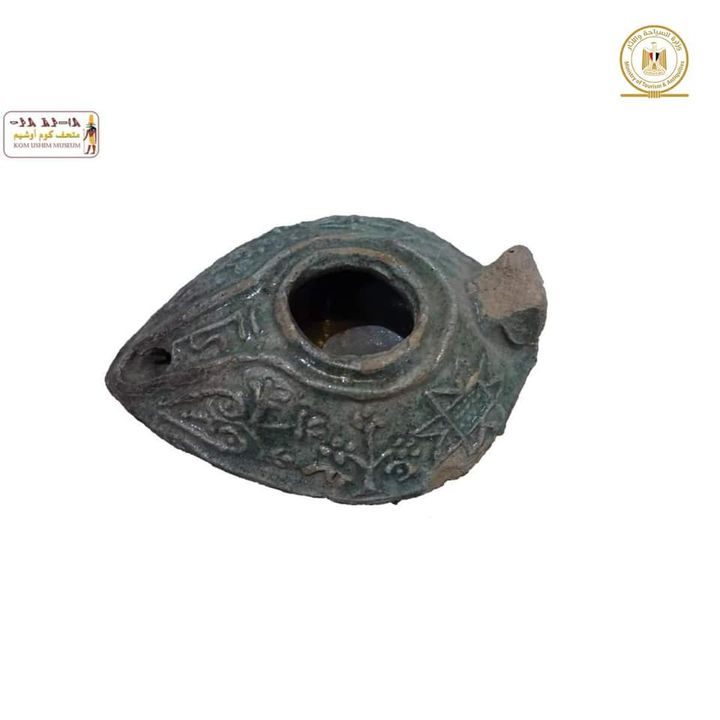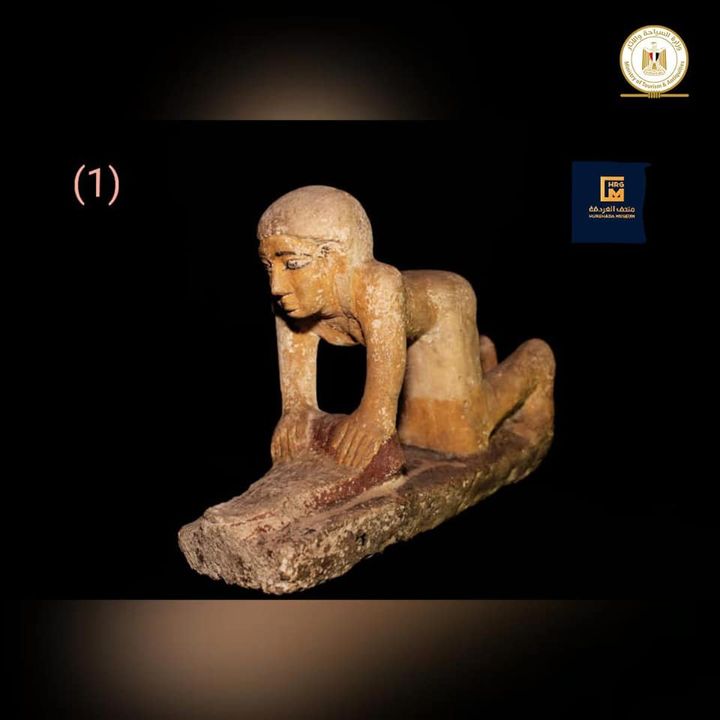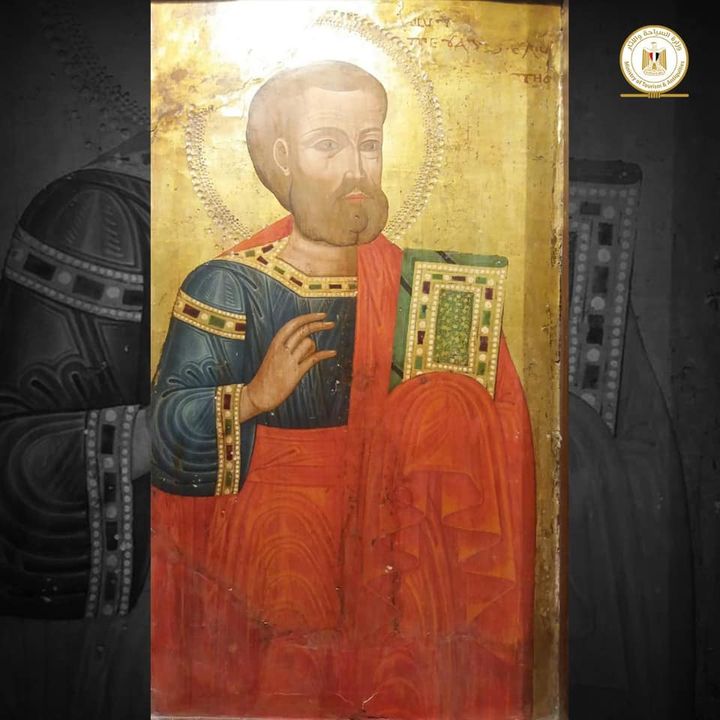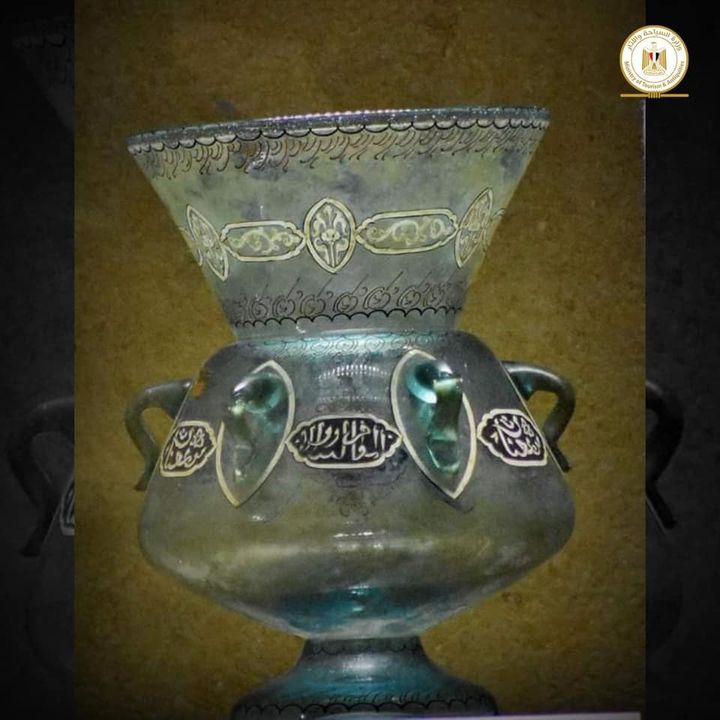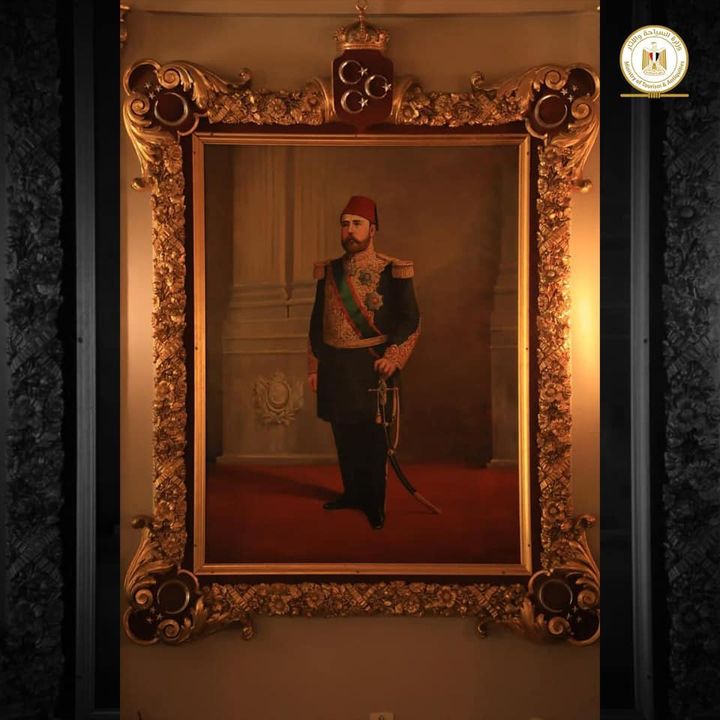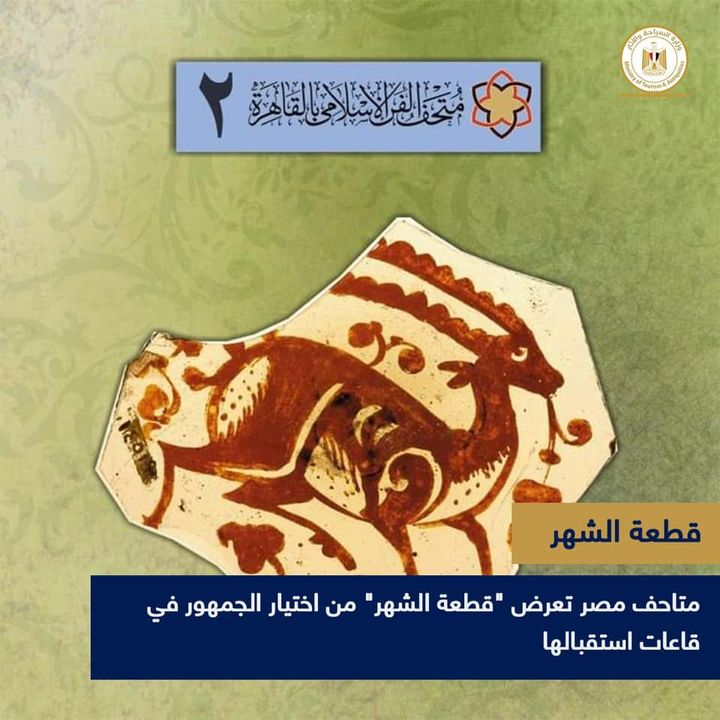متحف المركبات الملكية ببولاق:
فازت بالتصويت لهذا الشهر، القطعة رقم (2) والمعروضة بقاعة الاستقبال بالمتحف وهى “لوحة جنانيار هانم” لوحة زيتية بالحجم الطبيعي لجنانيار هانم إحدى زوجات الخديوي إسماعيل.
متحف آثار كوم أوشيم بالفيوم:
فازت إحدى مقتنيات المتحف الموجودة بسيناريو العرض المتحفي بالطابق الأرضي وهى مسرجة لوزية الشكل عليها زخارف وشكل نجمتين، لونها زيتونى، مصنوعة من الخزف وتعود للعصر الفاطمي.
متحف سوهاج:
فازت القطعة رقم ( 1 ) وهي تمثال مزدوج لرئيس العمال (نچم إيب) الذي كان من كبار رجال الدولة، وترقى في المناصب حيث حمل لقب رئيس العمال، المراقب لكبار الكهنة والسمير الأوحد للملك.
متحف التحنيط بالأقصر:
اختار الجمهور قطعة أثرية على شكل بطة محنطة حديثاً والتى قام بتحنيطها الدكتور ذكى اسكندر سنة 1942 م .
متحف المجوهرات الملكية بالاسكندرية:
فازت القطعة رقم 3 وهي علبة نشوق محمد علي باشا من مقتنيات الملك فاروق، وهب عبارة عن علبة بيضاوية الشكل من الذهب والفضة ، غطاء العلبة يتحرك على جسمها بواسطة مفصلة، ويتوسط الغطاء أنسيال من الفضة يقرأ ( محمد علي ) مرصع بأحجار من الماس ، وبجانبه حلية على شكل غصن الزيتون مرصعة بالماس .
متحف الفن الاسلامي:
فازت كسرة من الزجاج ذي البريق المعدني عليها رسم غزالة من العصر الفاطمي
القرن 5هـ/ 11م.
متحف ركن فاروق بحلوان:
فازت صورة فوتوغرافية لزفاف الملك فاروق والملكة ناريمان مسجل على الصورة توقيع (رياض شحاتة مصور جلالة الملك) الصورة داخل إطار من الخشب المذهب يعلوة شكل التاج الملكي،ومعروضة بغرفة نوم الملكة.
متحف شرم الشيخ:
فازت قطعة تمثل نموذجاً خشبياً يرجع لعصر الدولة الوسطى يصور صناعة الخبز في مصر القديمة حيث يقوم الشخص بالخلف بعمل عجين الخبز ووضعه فى قالب الخبز ويعطيه للشخص الأمامى لوضعه فى الفرن المصور أمامه.
متحف الغردقة:
فازت القطعة رقم (١) لتمثال من الحجر الجيري الملون يجسد مهنة “الطحان”، حيث يصور هذا التمثال الصغير رجلاً يقوم بطحن الحبوب بشكل نشيط حيث كان الخبز غذاءً أساسياً في مصر القديمة.
متحف آثار بني سويف القومي:
فقد تم اختيار القطعة رقم (١) وهي تمثال رقم ١٥٠١ من الحجر الجيرى لخادمة تصنع الخبز يوجد بقايا لون احمر وأسود، ، دولة قديمة.
متحف الاسماعيلية:
فقد فازت لوحة جنائزية لكاهنة حتحور فى منظر تقدمه للاله أوزير ويتوج اللوحة قرص الشمس المجنح – حجر جيرى – دولة قديمة.
متحف تل بسطا:
فازت مجموعة من المسارج وهى ادوات الإنارة لدى المصرى القديم ،حيث كان يوضع بها الزيت ومن أعلى الفتيل.
متحف السويس:
فازت مجموعة من السمك المجفف.
المتحف القبطي:
تم اختيار أيقونة ثمثل قيامة السيد المسيح من القبر حيث الأكفان موضوعة، وجهة اليسار توجد مجموعة من النساء يتجهن نحو القبر بينما اثنان من الجنود الثلاثة الذين كانوا يحرسون القبر نائمين امام القبر .
متحف الشرطة القومى بالقلعة:
تم اختيار قطعة أثرية تمثل شعار الشرطة المصرية عبارة عن نسر يحمل بين قدميه كلمة الشرطة ويحيط به فرعان لغصنين يمثلان السلام الاجتماعى ويعلوه اسم جمهورية مصر العربية.
متحف المنيل:
تم اختيار صورة زيتية للخديوي إسماعيل وهو واقفاً وعلى يمينة عمود مزدوج على قاعدة.
متحف كفر الشيخ:
فازت قطعة عبارة عن مشكاة من الزجاج الملون لونها أزرق شفاف.
المتحف اليونانى الرومانى:
تم اختيار رأس من البرونز للإمبراطور هارديان ، والذي زار مصر وأمضى فيها من 8-10 أشهر قام خلالها برحلة نيلية وأسس مدينة جديدة فى المنيا وأطلق عليها اسم أنتينوبوليس (حاليا الشيخ عباده بالقرب من تونا الجبل)، وقد سافرت هذه القطعة الأثرية ضمن قطع معرض “أسرار مصر الغارقة”، وقد تم رجوعها حتى تكون من ضمن المعروضات الأساسية بالمتحف اليونانى الرومانى عند افتتاحه قريبا.
متحف الوادى الجديد:
فاز تمثال من الخشب لطائر البا ناشرا جناحيه على رأسه قرص الشمس يعلوه طبقة من الجص الملون والوجه مذهب، ويرجع للعصر اليونانى الرومانى.
متحف الأقصر:
فاز ٣ قطع فى صورة واحدة، توضح المراحل التى يمر بها صب المعادن عند المصرى القديم ويظهر بها المعبود حورس من البرونز والمعبودة ماعت من شمع النحل والمعبود جحوتى من الطين، وترجع هذه القطع إلى عصر الدولة الحديثة.
لا يوجد من النحت المعدنى فى مصر القديمة سوى القليل وكان المعدن يصهر ويعاد استخدامه وهذه الطريقة تسمى بأسم الشمع المفقود.
متحف آثار مطروح:
القطعة الفائزة هي أيقونة القديس مرقص الرسول والتي يظهر بها القديس مرقص مؤسس كنيسة الاسكندرية والبطريرك الأول للمسيحيين فى مصر، وهذه الأيقونة مصنوعة من الخشب الملون وترجع للعصر القبطى.
In a monthly tradition performed by the Egyptian museums under the Supreme Council of Antiquities, where a distinctive display is held of an artifact chosen by the public through voting on the social networking site Facebook of these museums to be the “piece of the month”.
Royal Chariots Museum in Boulaq:
Piece 2 displayed in the museum’s reception hall, the “Jananyar Hanem Painting”, a life-size oil painting by Jananyar Hanem, one of Khedive Ismail’s wives won the vote for this month.
Kom Aushim Museum of Fayoum:
One of the museum’s collections in the ground floor museum exhibition scenario, an almond-shaped saddle with two-star decorations and figures, olive color, made of porcelain and dating back to the Fatimid era was chosen.
Sohag Museum:
Piece 1, a double statue of the workers’ chief (Njm Abe), who was a senior state man who rose to the office where he held the title of foreman, an observer of the high priests, and the sole prince of the king won.
Luxor Mummification Museum:
The audience chose a newly mummified duck artifact, which was embalmed by Dr. Zaki Iskandar in 1942.
Royal Jewelry Museum in Alexandria:
Piece 3 was the winning piece, it is the box of Nashuk Muhammad Ali Pasha from king Farouk’s possessions, which is an oval-shaped box made of gold and silver, the cover of the box moves using a hinge, and is mediated by a silver ansial that reads (Muhammad Ali) studded with diamonds, next to it an ornament in the form of an olive branch studded with diamonds.
Museum of Islamic Art:
The winning piece was a glass with metallic sparkle on it and a drawing of a Fatimid deer.
5th century H/11 AD.
King Farouk Corner Museum in helwan:
A photograph of the wedding of King Farouk and Queen Nariman with the signature (Riad Shehata, photographer of the King) inside a gilded wood frame topped with the shape of the Royal Crown that is displayed in the Queen’s bedroom was the winning piece.
Sharm el-Sheikh Museum:
A piece dating back to the middle state era depicting the bread industry in ancient Egypt where the person in the back makes bread dough and puts it in a baking mold and gives it to the front person to put it in the oven in front of him won.
Hurghada Museum:
Piece 1, a statue of colored limestone that embodies the profession of “tahan”, where this small statue depicts a man who is actively grinding grains since bread was an essential food in ancient Egypt won.
Beni Suef National Archaeological Museum:
Piece 1, a 1501 limestone statue of a bread-making maid with red and black remains, has been chosen.
Ismailia Museum:
A funeral plaque painting of a Hathor priest with the God Ozer, and the sun’s winged disc – Limestone – the ancient state was the winning piece.
Tel Basta Museum:
A set of saddles, the lighting tools of the old Egyptian, where the oil was placed from the top of the fuse was chosen.
Suez Museum:
A set of dried fish won.
Coptic Museum:
The icon of the resurrection of Christ from the grave where the shrouds were placed was chosen, on the left is a group of women heading towards the grave while two of the three soldiers guarding the tomb are asleep in front of the tomb.
National Police Museum of the Castle:
An artifact representing the logo of the Egyptian police was chosen as an eagle with the word police between its feet and surrounded by two branches of branches representing social peace and topped with the name of the Arab Republic of Egypt.
Al-Manial Museum:
An oil photograph of Khedive Ismail standing on the right of a double pole on a base was chosen.
Kafr Al-Sheikh Museum:
A glass niche colored translucent blue was chosen.
Greek-Roman Museum:
A bronze head of Emperor Hardian was chosen, he visited Egypt and spent 8-10 months on an indigo trip and founded a new city in Minya named After Antinopolis (currently Sheikh Abada near Tuna al-Jabal), and this artifact moved around with the pieces of the “Secrets of sunken Egypt” exhibition, and was returned to be among the main exhibits of the Greek-Roman Museum when it opens soon.
New Valley Museum:
A wood statue of the Alba bird with its wings on its head and a sun disk over with a layer of stained plaster and gilded face, dating back to the Greek-Roman era was the chosen piece.
Luxor Museum:
3 pieces in one image won, illustrating the stages of metal casting in ancient Egypt and showing the God “Horus” made of bronze, God “Maat” made of beeswax, and God “Gahoty” made of clay, and these pieces date back to the era of the modern state.
There is only a little metal sculpture in ancient Egypt and the metal was melted and reused and this method is called the lost wax.
Matrouh Antiquities Museum:
The winning piece is the icon of St. Morcos the Apostle, which shows St. Morcos, founder of the Church of Alexandria and the first patriarch of Christians in Egypt, and this icon is made of colored wood and dates back to the Coptic era.
Ministry of Tourism and Antiquities وزارة السياحة والآثار
